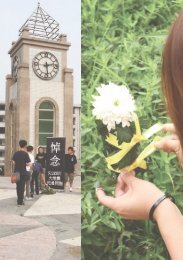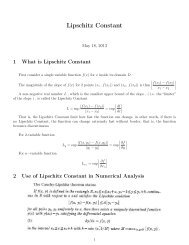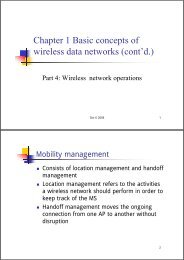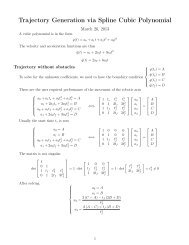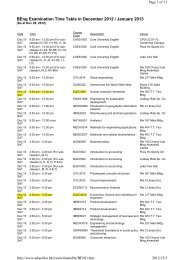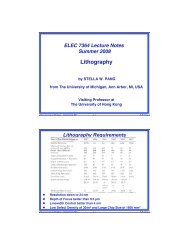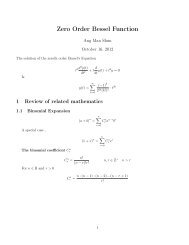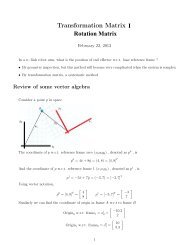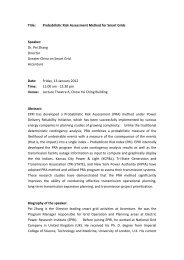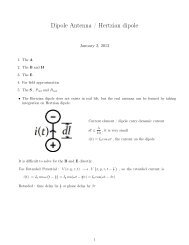The Working Principle of Ant Colony Optimization
The Working Principle of Ant Colony Optimization
The Working Principle of Ant Colony Optimization
Create successful ePaper yourself
Turn your PDF publications into a flip-book with our unique Google optimized e-Paper software.
<strong>The</strong> <strong>Working</strong> <strong>Principle</strong> <strong>of</strong> <strong>Ant</strong> <strong>Colony</strong> <strong>Optimization</strong><br />
May 29, 2013<br />
<strong>The</strong> <strong>Ant</strong> <strong>Colony</strong> <strong>Optimization</strong> Algorithm (ACO) is an probabilistic computational optimization<br />
technique to solve some path finding problem.<br />
<strong>The</strong> ACO is one <strong>of</strong> the example <strong>of</strong> Swarm Intelligent System.<br />
1 How do ants communicate : <strong>The</strong> pheromone<br />
<strong>The</strong> real ant will secrete a kind <strong>of</strong> chemical called “pheromone” for communication.<br />
<strong>The</strong> secreting ant will secrete pheromone.<br />
<strong>The</strong> receving ant’s behavior will be changed, it is more likely to follow the pheromone.<br />
2 <strong>The</strong> <strong>Principle</strong><br />
Initially the ants are all concentrated in the colony, and they need to find the location <strong>of</strong> food and<br />
bring the food home.<br />
In the begining, all ant move randomly.<br />
As the ant moves, it will lay down pheromone trials.<br />
Pheromone is attractive to ant : when other ants find move to the position with pheromone, they<br />
will tend to move along the path instead <strong>of</strong> moving in a random pattern.<br />
<strong>The</strong> pheromone will evaporate overtime, thus reducing the attractiveness to the ant.<br />
After some time ( some iterations ), the path with better performance will be strengthen ( since<br />
ants will follow the path more likely as well as lay down pheromone to strengthen the attraction, this<br />
is the positive feedback ! ) , the path with poor performance will disappear ( less attractive to ant +<br />
pheromone evapouration )<br />
And eventually, the ants will find the optimal path.<br />
1
3 Detail explanations<br />
Initially the ants are all concentrated in the colony, and they need to find the location <strong>of</strong> food and<br />
bring the food home, and the ant has no knowledge <strong>of</strong> the location <strong>of</strong> the food.<br />
<strong>The</strong>n the ant start to move at random, this can be modeled as random walks<br />
X k+1 = X k + hD k<br />
( i.e. the next location X k+1 = (x k+1 , y k+1 ) is the current location X k = (x k , y k ) plus the random<br />
step which is the product <strong>of</strong> step size h and direction D k = (d x,k + d y,k ) , where D k is generated by<br />
random number generator )<br />
As the ant move, it will lay down pheromone trials.<br />
Some ant will find the food (not necessary the optimal solution)<br />
2
Direction Selection<br />
Now consider the ant moving method with and with out pheromone. <strong>The</strong>re are lots <strong>of</strong> direction<br />
selection scheme , for example, consider the simple 4-direction selection scheme :<br />
When there is no pheromone, the ant just perform random walk, thus the chance <strong>of</strong> moving to any<br />
direction is equal.<br />
When there is pheromone, the chance <strong>of</strong> the ant to travel along the pheromone trials will be higher,<br />
for example, 40%. And other remaining directions will be lower.<br />
<strong>The</strong> above method is simple and easy to implement, in general, the scheme can be implemented as<br />
In the above scheme, there 8 possible directions ( since in pixel geometry, there are 8 directions in total ! )<br />
<strong>The</strong> chance <strong>of</strong> picking any direction with no pheromone is evenly distributed<br />
When there is pheromone, the chance <strong>of</strong> picking the direction with pheromone is higher : P p which<br />
is the probability from the preference function ( P p ∈ [0, 1] ), and all the remaining 7 direction has equal<br />
chance <strong>of</strong> being selected : 1 − P p<br />
7<br />
<strong>The</strong> above scheme is already good enough, but further improvement can be made by lowering the<br />
chance <strong>of</strong> the ant to “turn back”<br />
Where a, b can be a constant or output <strong>of</strong> some preference function<br />
3
<strong>The</strong> scheme can be made even more complicated if the pheromone also attract the ant to move<br />
toward the pheromone direction<br />
Where the chance <strong>of</strong> the ant to move in specific direction is determined by the preference function.<br />
<strong>The</strong> preference function can be deterministic, or fuzzy. For example, the preference function can be<br />
an gaussian or discrete.<br />
⎧<br />
+a 1 for most attractive<br />
⎪⎨ +a 2 for attractive<br />
For example p = +a 3 for normal<br />
⎪⎩<br />
+a 4 for not so attractive<br />
+a 5 for least attractive<br />
where ∑ a i = 1 and a i can be negative. ( then positive number means favour and negative number<br />
means unfavour)<br />
Thus in thus direction selection scheme, for example<br />
<strong>The</strong> probability <strong>of</strong> direction selection ⎧ <strong>of</strong><br />
⎨ p 8 = a<br />
1. the case with no pheromone :<br />
⎩ p other = 1 − a<br />
7<br />
, where a is defined as above.<br />
2. the upper case with pheromone<br />
⎧<br />
p 1 = p 7 = b 7 + a 4<br />
⎪⎨<br />
p 2 = p 6 = b 7 + a 3<br />
p 3 = p 5 = b 7 + a 2<br />
( notics that ∑ p i = 1)<br />
p 4 = b 7 ⎪⎩<br />
+ a 1<br />
p 8 = a 5 − b<br />
3. the lower case with pheromone<br />
⎧<br />
p 3 = b 7 + a 1<br />
⎪⎨<br />
p 2 = p 4 = b 7 + a 2<br />
p 1 = p 5 = b 7 + a 3<br />
p 6 = b 7 + a 4<br />
⎪⎩<br />
p 7 = b 7 + a 5<br />
p 8 = a 4 − b<br />
4
Now consider a binary path selection problem to understanding this algorithm<br />
Initially there are totally 100 ants, 50 ants in net and 50 ants in the food area.<br />
<strong>The</strong>re are 2 possible path, path 1 (shorter) , path 2 (longer).<br />
Since it takes longer time to travel thru path2, thus pheromone in path 2 will keep dropping ( by<br />
evapouration ) and pheromone in path 1 will accumulate, and this process will favour more ants to<br />
choose path 1, thus the number <strong>of</strong> ants taking path 1 will increase, and drop for path 2.<br />
Finally all ants will chose path 1 ( the optimal path ).<br />
This example shows that the ACO method favours short path, thus this method can be used in<br />
solving the NP-hard T ravelling salesman problem<br />
−END−<br />
5



